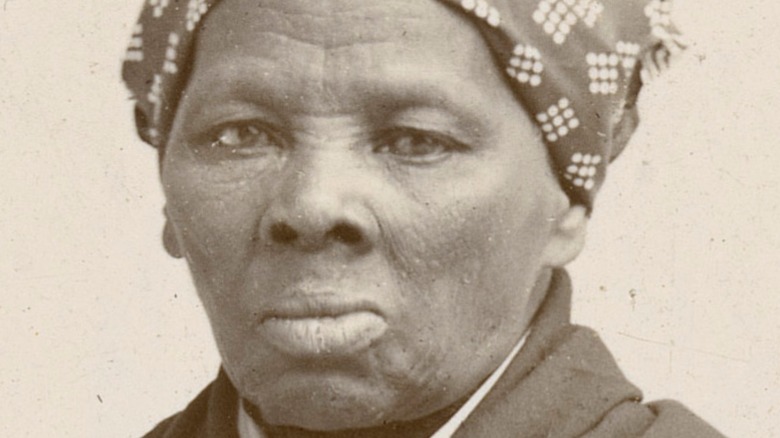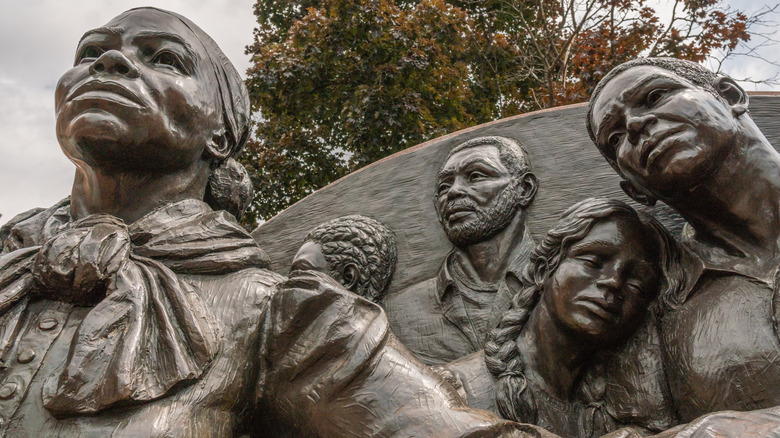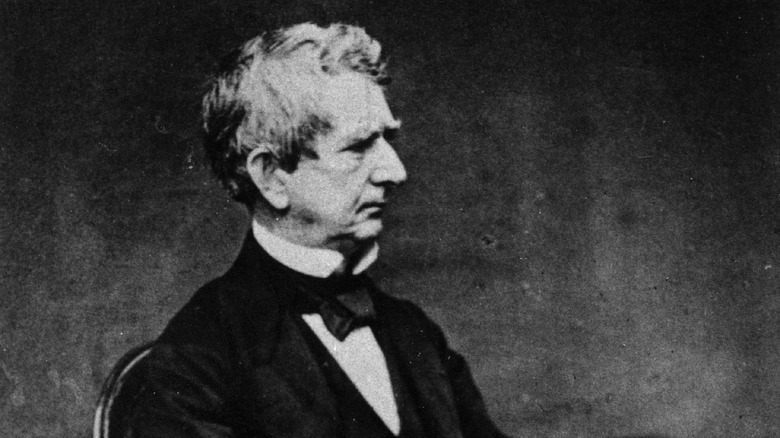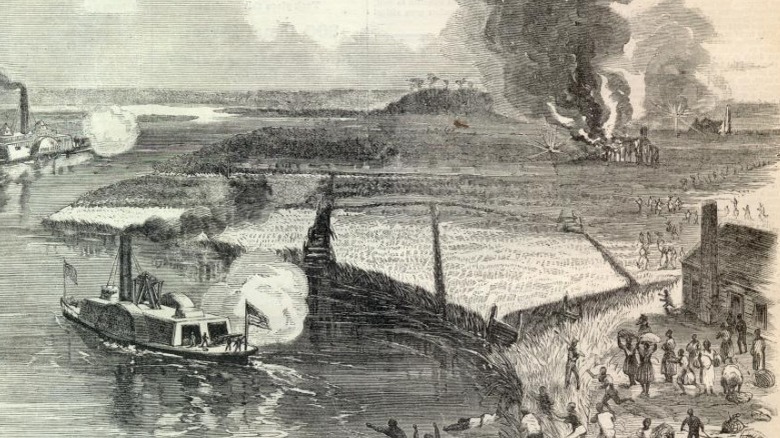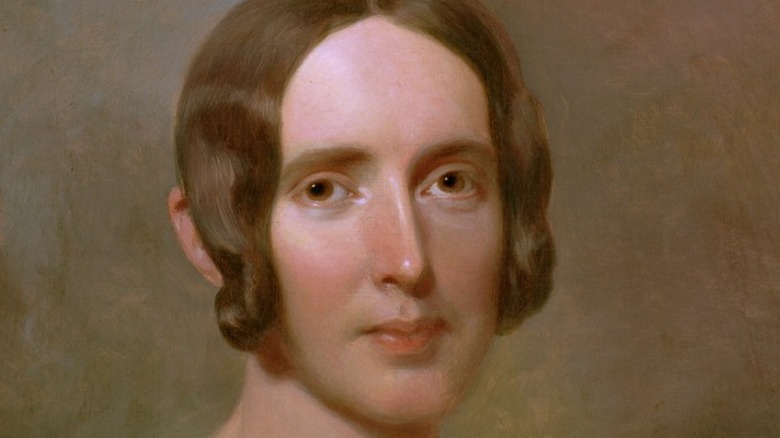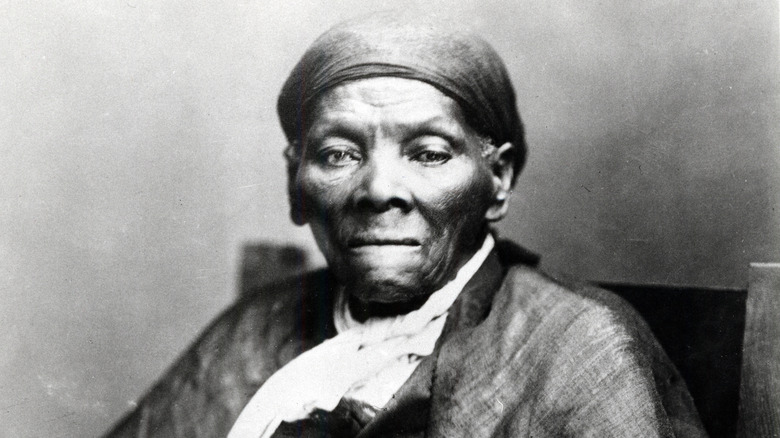Abraham Lincoln's Secretary Of State William Seward And Harriet Tubman's Relationship
It's hard to imagine two such different people as Harriet Tubman and William Henry Seward being friends. One was born into slavery in Maryland, the other into a comfortable farm family who owned enslaved people in Upstate New York. One would risk her life to free dozens of enslaved people from the South before and during the Civil War and act as a Union spy, per History. The other would fight for years against the evils of slavery through the highest corridors of political power, from New York governor to U.S. senator and finally President Abraham Lincoln's secretary of state, per the U.S. Office of the Historian for the Department of State.
Tubman and Seward, along with Seward's wife, Frances, were united in a fight to end slavery in the United States. They would end up living close to each other in Auburn, New York, and achieve their goal with the passage of the 13th Amendment to the Constitution that ended slavery. "I have known her long, and a nobler, higher spirit, or a truer, seldom dwells in the human form," Seward would say of Tubman, according to the 1869 book "Scenes in the Life of Harriet Tubman."
The Underground Railroad
Beginning around 1810, the Underground Railroad, a network of safe houses and people from all walks of life, including the formerly enslaved, helped thousands of enslaved people find freedom in the North and in Canada, per National Geographic. In 1849, Harriet Tubman, born Araminta Harriet Ross circa 1820, made a bid for freedom that would inspire others both white and Black, and save countless people from the horrors of slavery, per Biography.
Tubman, using the Underground Railroad, and making use of various disguises, such as carrying chickens so whites would assume she was a field hand, per the American Battlefield Trust, made it to Philadelphia, which was in a free state and was a stronghold for abolitionism, where Blacks could find work and education. It was there that she met an acquaintance of Frances Seward, the Quaker minister and abolitionist Lucretia Mott, who likely introduced the two. Tubman soon returned to Maryland to rescue enslaved family members and others and became an inspiration to Frances and William Seward (per The New Yorker).
Who Were William and Frances Seward?
When William Henry Seward was a child in the early 1800s, he had a playmate, Zeno, who was enslaved and abused by the Seward's neighbors, per Seward's 1877 autobiography. At the time, New York still allowed slavery (it would be outlawed in 1827, per the Historical Society of the New York Courts). This and other incidents "determined me, at that early age, to be an abolitionist," he recalled in his autobiography. But when he became a politician, he was more cautious about his abolitionist stance. Even so, as a U.S. senator, he voted against the Fugitive Slave Act in 1850 (which passed anyway) that made it a crime to help runaway enslaved people, according to The New Yorker.
It was around this time that Frances Seward, who didn't have the same qualms as her husband, opened up their home in Auburn, New York, as a stop on the Underground Railroad, with Seward's blessing, per The New Yorker. This was a risky move since if it became known, Seward's political career could suffer and he and Frances would be considered criminals under federal law. Seward trusted his wife, who often acted as his advisor, per The Seward/Mapes Homestead.
Harriet Tubman becomes a nurse, a Union scout, and spy
In 1859, Frances Seward sold some of the property she inherited from her family to Harriet Tubman and her parents, whom Tubman had rescued from Maryland. Frances and William had been selling off some of their lands around Auburn to Blacks so that they could become homeowners, which in New York meant they were eligible to vote (if they were male), per The New Yorker.
Tubman didn't remain in Auburn long. She continued her dangerous missions to the South to guide more enslaved people to freedom. "I have heard their groans and sighs and seen their tears, and I would give every drop of blood in my veins to free them," Tubman remarked, per "Scenes in the Life of Harriet Tubman." She acted as a nurse and cook for the Union Army and a spy and scout, per Biography. In June 1863, Tubman and 150 Black Union soldiers raided Combahee Ferry in South Carolina, and rescued more than 700 enslaved people, making Tubman the first woman to lead a major military operation in the war, according to Smithsonian.
William and Frances Seward suffer a tragedy
While Harriet Tubman was fighting for the Union cause, William Henry Seward was in Washington, D.C. He became President Abraham Lincoln's secretary of state in 1861, was one of Lincoln's closest advisors, and kept the position during the entirety of Lincoln's tenure, according to Britannica. On April 14, 1865, Lewis Powell stabbed Seward in the throat and attacked his two sons, the same night that John Wilkes Booth assassinated Lincoln, per CBS News. Seward and his sons survived, but the shock of nearly losing her husband and two sons to an assassination attempt likely affected Frances' delicate health. She had a heart attack and died on June 21, 1865, aged 60, according to History of American Women.
Seward continued on as secretary of state for Lincoln's successor, Andrew Johnson, per Britannica. In 1867, Seward negotiated the purchase of Alaska from Russia, in what at the time was derisively called "Seward's Folly," according to History. After leaving office in 1869, he returned to Auburn, where his friendship with Tubman deepened.
Harriet Tubman returns to Auburn, New York
While Harriet Tubman was fighting for the Union, Frances took in and educated Tubman's niece, Margaret Williams, per History of American Women. After the war, Tubman returned to her home in Auburn and married Nelson Davis, a Union veteran. She would remain in Auburn for the rest of her life, but traveled to support the causes she continued to pursue, including women's rights, per History, Art & Archives of the United States House of Representatives.
She was never financially secure, yet continued to help others. At one point, Seward, who lived close by, chided Tubman for being so self-sacrificing. "Harriet, you have worked for others long enough," he told her. "If you ask for a donation for yourself, I will give it to you; but I will not help you to rob yourself for others," per "Scenes in the Life of Harriet Tubman." Seward also tried to help her get a pension from the U.S. government for her service during the Civil War. It would take 34 years for Tubman to receive compensation, but not the recognition for her military service, per History, Art & Archives. By that time, Seward was long dead. He died in 1872 in Auburn, per Britannica. Tubman would die in 1913 at the home for the aged that she founded, per the American Battlefield Trust. Today, a statue dedicated to the unique relationship between Tubman and Seward and their roles in changing the world for the better stands in Schenectady, New York, per WRGB News.
